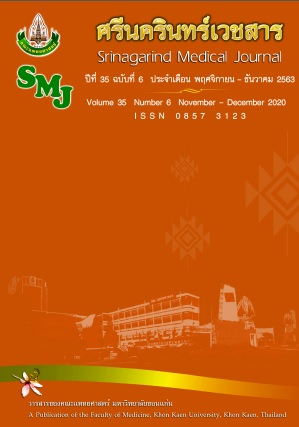Update on Mechanism of Insulin Resistance and New Trend of Drug Development
Keywords:
Insulin resistance; lipotoxity; glucotoxicity; ER-stress; New trend drugsAbstract
Insulin plays a crucial role in regulating the proper metabolic and energy balance. Once insulin signal transmissions are decreased, this can lead to a condition known as “insulin resistance”.
Difference mediators, such as pro-inflammatory cytokines, free fatty acids, blood glucose and ROS level can increase the activity of kinases, i.e. several Protein kinase C (PKC) isoforms, c-Jun N-terminal kinases (JNK), Protein kinase A (PKA), Mammalian Target of Rapamycin (mTOR) and Mitogen-Activated Protein Kinase (MAPK), which affecting the signal of insulin receptors, IRS, and downstream-located effector molecules. Therefore, better understanding on the molecular mechanisms of these pathways is important for developing a more effective treatment of insulin resistance and associated diseases.
This review summarizes the current knowledge on the mechanism of insulin resistance, the diseases associated with insulin resistance and biological effects of recent agents, which are developed for increasing insulin signaling, and are currently undergoing clinical trials.
References
2. Boucher J, Kleinridders A, Kahn CR. Insulin receptor signaling in normal and insulin-resistant states. Cold Spring Harb Perspect Biol. 2014; 6(1): 1-23.
3. Boonloh K, Kukongviriyapan U, Pannangpetch P, Kongyingyoes B, Senggunprai L, Prawan A, et al. Rice bran protein hydrolysates prevented interleukin-6- and high glucose-induced insulin resistance in HepG2 cells. Food Funct. 2015; 6(2): 566-573.
4. Ronn SG, Billestrup N, Mandrup-Poulsen T. Diabetes and suppressors of cytokine signaling proteins. Diabetes. 2007; 56(2): 541-548.
5. Johnson AM, Olefsky JM. The origins and drivers of insulin resistance. Cell. 2013; 152(4): 673-684.
6. Holland WL, Bikman BT, Wang LP, Yuguang G, Sargent KM, Bulchand S, et al. Lipid-induced insulin resistance mediated by the proinflammatory receptor TLR4 requires saturated fatty acid-induced ceramide biosynthesis in mice. J Clin Invest. 2011; 121(5): 1858-1870.
7. Fu S, Watkins SM, Hotamisligil GS. The role of endoplasmic reticulum in hepatic lipid homeostasis and stress signaling. Cell Metab. 2012; 15(5): 623-634.
8. Zhang XQ, Xu CF, Yu CH, Chen WX, Li YM. Role of endoplasmic reticulum stress in the pathogenesis of nonalcoholic fatty liver disease. World J Gastroenterol. 2014; 20(7): 1768-1776.
9. Montgomery MK, Turner N. Mitochondrial dysfunction and insulin resistance: an update. Endocr Connect. 2015;4(1):R1-R15.
10. Sah SP, Singh B, Choudhary S, Kumar A. Animal models of insulin resistance: A review. Pharmacol Rep. 2016;68(6):1165-1177.
11. Escobar-Morreale HF. Polycystic ovary syndrome: definition, aetiology, diagnosis and treatment. Nat Rev Endocrinol. 2018;14(5):270-284.
12. Literati-Nagy B, Kulcsar E, Literati-Nagy Z, Buday B, Peterfai E, Horvath T, et al. Improvement of insulin sensitivity by a novel drug, BGP-15, in insulin-resistant patients: a proof of concept randomized double-blind clinical trial. Horm Metab Res. 2009;41(5):374-380.
13. Literati-Nagy B, Tory K, Peitl B, Bajza A, Koranyi L, Literati-Nagy Z, et al. Improvement of insulin sensitivity by a novel drug candidate, BGP-15, in different animal studies. Metab Syndr Relat Disord. 2014;12(2):125-131.
14. Digenio A, Pham NC, Watts LM, Morgan ES, Jung SW, Baker BF, et al. Antisense Inhibition of Protein Tyrosine Phosphatase 1B With IONIS-PTP-1BRx Improves Insulin Sensitivity and Reduces Weight in Overweight Patients With Type 2 Diabetes. Diabetes Care. 2018;41(4):807-814.
15. Kaur R, Dahiya L, Kumar M. Fructose-1,6-bisphosphatase inhibitors: A new valid approach for management of type 2 diabetes mellitus. Eur J Med Chem. 2017;141:473-505.
16. Egan A, Vella A. TTP399: an investigational liver-selective glucokinase (GK) activator as a potential treatment for type 2 diabetes. Expert Opin Investig Drugs. 2019;28(9):741-747.
17. Maccari R, Del Corso A, Paoli P, Adornato I, Lori G, Balestri F, et al. An investigation on 4-thiazolidinone derivatives as dual inhibitors of aldose reductase and protein tyrosine phosphatase 1B, in the search for potential agents for the treatment of type 2 diabetes mellitus and its complications. Bioorg Med Chem Lett. 2018; 28(23-24): 3712-20.
18. Arab JP, Arrese M, Trauner M. Recent Insights into the Pathogenesis of Nonalcoholic Fatty Liver Disease. Annu Rev Pathol. 2018; 13: 321-350.
19. DePaoli AM, Higgins LS, Henry RR, Mantzoros C, Dunn FL, Group INTS. Can a selective PPARgamma modulator improve glycemic control in patients with type 2 diabetes with fewer side effects compared with pioglitazone? Diabetes Care. 2014;37(7): 1918-1923.




